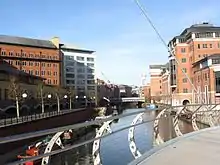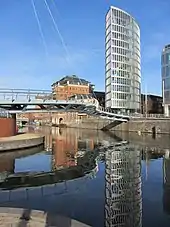Temple Quay
Temple Quay is an area of mixed-use development in central Bristol, England. The project was initiated by Bristol Development Corporation in 1989, under the name Quay Point until 1995. In that year it was handed over to English Partnerships, under whom development eventually started in 1998. It is bounded by Temple Way (the A4044) to the west and Bristol Temple Meads railway station to the southeast; to the northeast the development was bounded by Bristol Floating Harbour until 2002, when development of Temple Quay North started on the harbour's other side. In 2012 the whole area became part of Bristol Temple Quarter Enterprise Zone.

Temple Quay includes a significant amount of office accommodation occupied by UK Government departments and agencies including Homes England, The Planning Inspectorate, Insolvency Service, Care Quality Commission, Ofsted and English Heritage.[1][2]
History

A section of the Portwall, which was a part of Bristol's 13th-century city wall, with a deep ditch on its outer side, formerly ran from southwest to northeast across the site of the modern development. This section ran from the medieval Temple Gate, at the end of modern Redcliffe Way, to the medieval river bank, now the Floating Harbour, where the wall terminated with a fortified tower called Tower Harratz. The wall's course through the site in medieval times was marked up to the 20th century by Pipe Lane.[3]
From 1841, the area southeast of Pipe Lane was developed by the Great Western Railway as a goods yard for Temple Meads station. The original goods shed, built by Isambard Kingdom Brunel in 1841–2, was soon extended, and a dock was excavated alongside it, to allow the transfer of goods on and off barges in the Floating Harbour.[4] The goods shed was rebuilt and expanded in 1874–6, when the dock was filled in and replaced with a new barge wharf, and again in 1924. It was eventually closed in August 1982 and demolished.[5]
Originally called Quay Point, the Temple Quay development was the largest project initiated by Bristol Development Corporation. From 1989 to 1995 the corporation considered office or retail possibilities, until in 1995 it decided on a mixed-use development, to also include residential use, and named it Temple Quay. In December 1995, not yet having found a developer for the site, and about to be wound down, the corporation transferred its rights on the site to English Partnerships. In 1998 work began on remodelling the road access via Temple Gate.[6] The developer eventually found for Temple Quay was Castlemore Securities. When Castlemore went into administration in 2009, development continued in the hands of the administrator, PricewaterhouseCoopers.[7]

The Bristol and West Building, completed in 2000 to a monolithic butterfly plan, dominated the waterfront. By 2002, the development south of the Floating Harbour was largely complete and a new phase was started on the other side of the harbour, called Temple Quay North.[8] This includes The Eye, a 13-storey tower which is eye-shaped in plan.[9]
In 2004 Six Portwall Markers, a sculptural group by John Aiken consisting of a sequence of six black granite blocks, was positioned along Rivergate, the modern street which follows the course of the Portwall. There is a view through the northernmost one down to the remains of a medieval watergate. Further north, the foundations of Tower Harratz lie under the Bristol and West Building.[10]
An S-shaped footbridge, supported by a raking mast, was built across the harbour in 2000,[8] named Valentine Bridge.[11] Another footbridge, named Meads Reach, was built in 2008, entirely out of stainless steel. It is covered in 55,000 perforations, which create vivid lighting effects at night. The surface was given dimples for slip resistance,[12] but in 2015 it was coated with polyurea to provide a better non-slip surface.[13]
In 2012, the entire Temple Quay development area became part of Bristol's enterprise zone, the Bristol Temple Quarter Enterprise Zone.[14]
In August 2015, Entrepreneurial Spark, a UK-wide business incubator network, opened a hub on the top floor of the Royal Bank of Scotland's Trinity Quay building in Temple Quay North.[15] Managed by NatWest, the hub provides free space, facilities and guidance for startup companies. 80 companies were selected for the first intake in 2015. Intakes occur every six months, with the most promising companies allowed to stay for up to 18 months.[16]
References
| Wikimedia Commons has media related to Temple Quay. |
- "Is Whitehall of North back on track in city?". Manchester Evening News. 13 February 2015. Retrieved 13 March 2017.
- Winnie Agbonlahor. "Civil service jobs to leave Whitehall for suburbs". Civil Service World. Retrieved 13 March 2017.
- Ponsford, Michael (1986). "Bristol". In Aston, Michael; Iles, Rob (eds.). The Archaeology of Avon. Bristol: Avon County Council. pp. 152–4. ISBN 0-86063-282-2.
- Binding, John (2001). Brunel's Bristol Temple Meads. Hersham: Oxford Publishing. pp. 110–5. ISBN 0-86093-563-9.
- Maggs, Colin G. (1996). Rail Centres: Bristol. Shepperton: Ian Allan Publishing. pp. 110–20. ISBN 0-7110-2476-6.
- Oatley, Nick; May, Andrew (1999). "'Out of touch, out of place, out of time': a valediction for Bristol Development Corporation". In Imrie, Rob; Thomas, Huw (eds.). British Urban Policy: An Evaluation of the Urban Development Corporations. London: Sage Publications. pp. 190–6.
- "Bristol building work 'will be completed'". Bristol Post. 4 March 2009. Retrieved 20 December 2016.
- Foyle, Andrew (2009). Pevsner Architectural Guide, Bristol. New Haven: Yale University Press. p. 267. ISBN 978-0-300-10442-4.
- Clensy, David (3 May 2016). "Twenty years of architectural evolution for Bristol". Bristol Post. Retrieved 21 December 2016.
- Merritt, Douglas; Greenacre, Francis; Eustace, Katharine (2011). Public Sculpture of Bristol. Liverpool: Liverpool University Press. p. 237. ISBN 978-184631-638-8.
- Gardner, Rachel (12 January 2015). "Repair work to Bristol's 'dangerous' Valentines Bridge hit by delays – while cyclists banned from riding over cheese grater bridge". Bristol Post. Retrieved 21 December 2016.
- Spring, Martin (23 July 2010). "Meads Reach footbridge, Bristol". Building Design. Retrieved 21 December 2016.
- Pavid, Katie (12 February 2015). "Cheesegrater bridge in Bristol to be dismantled and resurfaced to prevent slips and trips". Bristol Post. Retrieved 21 December 2016.
- "An enterprising idea with a radically new approach". Bristol Post. 8 July 2013. Archived from the original on 2 April 2015. Retrieved 18 March 2015.
- Clensy, David (29 November 2016). "E-sparks – where fledgling firms find their wings". South West Business. Retrieved 6 January 2017.
- Yong, Michael (16 September 2015). "Entrepreneurial Spark hub by NatWest launches in Bristol". South West Business. Retrieved 6 January 2017.

- Prince's Wharf, including M Shed, Pyronaut and Mayflower adjoining Prince Street Bridge
- Dry docks: SS Great Britain, the Matthew
- St Augustine's Reach, Pero's Bridge
- Bathurst Basin
- Queen Square
- Bristol Temple Meads railway station
- Castle Park
- Redcliffe Quay and Redcliffe Caves
- Baltic Wharf marina
- Cumberland Basin & Brunel Locks
- The New Cut
- Netham Lock, entrance to the Feeder Canal
- Totterdown Basin
- Temple Quay
- The Centre
- Canons Marsh, including Millennium Square and We The Curious
- Underfall Yard
- Bristol Bridge
